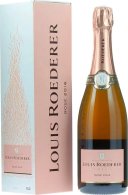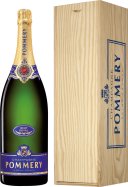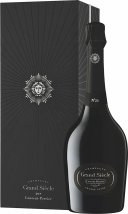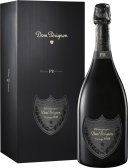$100 and over
Pol Roger Brut Non-Vintage Champagne
The guiding principles of blending are the achievement of harmony and consistency. The White Foil blend is traditionally composed from around 80 still base wines, drawn from different vineyard sites (crus), grape varieties and vintage years. The blend contains approximately one third of each three grape varieties of Champagne. Pinot Noir contributes body, depth of character and life extending tannins, Pinot Meunier adds youthful freshness, vigour and plump fruit character while Chardonnay gibes lightness, elegance and firmness.
House of Arras Blanc de Blancs
Australia's premier sparkling winemaker, Ed Carr, produces elite sparkling wines that border on the perfection. The equal to any prestigious Champagne, House of Arras have a track record of releasing Australia's finest examples. Here the new Arras Blanc de Blancs is the latest to join the range and is a sparkling wine that truly expresses the attributes of prestige Tasmanian Chardonnay, meticulous winemaking and extensive age on yeast lees. Hands on techniques including gentle whole bunch pressing, fermentation on light lees which went through 100% malolactic and almost 10 years in tirage were employed. The wine itself is a masterpiece that possesses a brilliant clarity and ultra-fine persistent bead. Lifted citrus of grapefruit and lemon zest are complimented with buttered toast.
Veuve Clicquot Yellow Label Non-Vintage
Yellow Label is the signature of Veuve Clicquot’s quality and style, recreated every year thanks to our priceless collection of reserve wines. Its label reflects the champagne’s bright personality and impeccable winemaking credentials.
Louis Roederer Vintage Rosé Champagne
Today Louis Roederer remains one of the very few remaining family owned Houses in Champagne with 7th generation Frederic Rouzaud at the helm. Louis Roederer Rosé Champagne 2015 is an extraordinary vintage which is also the year in which the Champagne region was recognised as a UNESCO World Heritage Site! The first impression of the wine is of a generosity, softness and concentration. One has the sensation of biting into juicy, ripe fruit and blood orange, it is a fabulous aromatic explosion with luscious and slightly tangy overtones. The concentrated and dense body takes over and reinforces the impression of substance, of concentrated liqueur on the mid-palate. The finish stretches out, perfectly-honed, gradually revealing umami notes thanks to the precise and crisp mineral freshness. Note - the image of the gift box differs slightly.
Dom Pérignon Brut Vintage (Gift Boxed)
The Dom Pérignon Brut Vintage 2015 is a wine that encapsulates the essence of a year marked by extreme contrasts, making it a memorable release in the prestigious legacy of Dom Pérignon. The vintage is a beautiful manifestation of the unique conditions of the 2015 growing season, with its dramatic shifts in climate leading to a wine of exceptional richness, balance, and character. Initially restrained, the 2015 vintage opens up over time, revealing a broad palate that evolves into a harmonious blend of complex aromas and vibrant fruit flavours. With its unique combination of floral notes, roasted nuances, and delicate freshness, the wine is a true expression of the exceptional terroirs that define Dom Pérignon. Presented in a beautifully designed gift box, it makes for a perfect collector’s item or a sophisticated gift for any wine connoisseur. The Dom Pérignon Brut Vintage 2015 is an exceptional wine for pairing with luxurious, high-end dishes. Its complexity and balance make it an ideal companion to seafood, particularly caviar, king crab, and langoustine. The wine’s delicate profile also complements meats with tangy notes, such as roasted pork, lamb, or duck. For a truly unique experience, try pairing this vintage with exotic fruits like kiwi and guava, or dishes with green curry spices, to accentuate its stimulating complexity. Maker: In 1668, Dom Pierre Pérignon was appointed procurator at the Abbey of Hautvillers. For 47 years, he worked to make the “best wine in the world”. Three centuries later, the Maison Dom Pérignon perpetuates this creative ambition through the constantly renewed quest for harmony as a source of emotion. All creative processes have their constraints. Dom Pérignon’s constraint is the vintage: an ambition to bear witness to the harvest of a single year, whatever the challenges may be, even if it means choosing not to declare the vintage. Dom Pérignon is always an assemblage, forming the foundation of the Dom Pérignon style. It is guided by timeless principles that have always taken precedence over winemaking techniques and their evolution. Time is also part of the equation for Dom Pérignon. During the time of active maturation on the lees, in the darkness of the cellars, the aesthetic and sensory values of each vintage are played out: precision, intensity, touch, minerality, and complexity. Dom Pierre Pérignon's legacy has often been misconceived, overshadowed by myths of inventing Champagne, and even unfounded rumours of blindness. However, what remains true beyond doubt is his extraordinary hard work and dedication to crafting the finest wine in the world. His innovations were groundbreaking. He developed the gentle 'coquard' press, which enabled him to produce clear, still white wine from black grapes. Pérignon also understood the unique challenges of Champagne's marginal climate, pioneering the art of blending grapes from different vineyards to create a more complete and balanced wine. His use of stronger verre anglais ('English glass') bottles, designed to withstand pressure, and the reintroduction of cork as a reliable closure were crucial advancements in winemaking. Through his tireless efforts, Pérignon laid the groundwork for the Champagne and the modern wine world. Philosophy: The philosophy behind Dom Pérignon is one of unwavering commitment to creating Champagne that transcends time, showcasing both the current expression and the potential for future development. Dom Pérignon believes that great Champagne is not simply made—it is born out of nature’s elements and transformed through time, patience, and a deep passion for excellence. With a focus on vintage production, Dom Pérignon captures the essence of each harvest, allowing each bottle to express the unique conditions of the year and the terroir it comes from. The House’s philosophy is reflected in its approach to both blending and aging. Each vintage is crafted to express the duality of fruit and structure, with a delicate balance between power and elegance. The wines are carefully aged to allow them to evolve, with each bottle revealing new dimensions of flavour and complexity as it matures. Dom Pérignon’s philosophy extends beyond just winemaking—it is about creating something that will stand the test of time, an expression of both the present and the future. Tasting Notes Nose Roasted, Floral, Spicy Deep, roasted notes of cacao powder and toasted aromas, gradually unfolding to reveal floral fragrances of lime blossom, jasmine, and peony. A spicy dimension of anise and cardamom adds depth, while a touch of green papaya and orange peel invigorate the overall profile. Palate Broad, Tactile, Generous The wine is broad and tactile, spreading across the tongue with a delicate yet generous texture. Fresh peach, nectarine, and citrus are complemented by sculpted bitter notes of citrus and gentian, creating a harmonious and balanced tasting experience. Finish Fresh, Balanced, Long The finish is long and smooth, with a lingering sweetness that ties together the bright, fresh fruit and the subtle bitterness. The wine’s vibrant acidity and finely textured tannins leave a lasting, memorable impression. The 2015 Dom Pérignon is terrific. Bright and poised, the 2015 shows terrific energy. Citrus peel, white flowers, mint, white pepper and slate all race across the palate. There's gorgeous tension and backbone here, with bright saline notes that extend the mid-palate and finish. This is a fine showing in a vintage that has proven to be tricky. I am intrigued to see how the 2015 develops in the coming years. 2025-2045. - Antonio Galloni (03/2024), Vinous, 96 Points. Disgorged in January 2023, the 2015 Dom Pérignon shows a singular, ethereal profile with aromas of white pepper, iodine, ripe orchard fruits, toast, smoke, herbs and spices. Medium to full-bodied, layered, and structured, it’s enveloping and round with a delicate phenolic mid-palate that underlines chalky dry extracts, concluding with a sapid, penetrating finish with gastronomic bitterness. This iteration of Dom Pérignon, though replete with the customary charm and vinous generosity that typify the label, distinguishes itself by its structural delicate austerity and a notably phenolic profile, giving rise to a remarkably linear and well-defined style that diverges markedly from the more familiar expressions of Dom Pérignon. - Yohan Castaing (05/2024), Wine Advocate, 95 Points. Remarkably pale at this early stage in the glass, the nose hits Dom Pérignon's classic gunsmoke and flint notes together with sweet and bright citrus. Packed with silky ripe fruits on both nose and palate, this is approachable now. Notes of fresh mint and fresh bread dough add to the layers on the palate, which has a creamy mousse but well-defined and vibrant acidity. Chalky in texture on the finish, this is ready to drink but will doubtless evolve well in bottle for over a decade. - Thomas Parker MW (07/2024), 94 Points.
Pommery Brut Royal Non-Vintage
Established in 1836, Madame Pommery is credited with creating the first vintage brut style of Champagne in 1874, at a time when most champagnes were excessively sweetened with sugar. This revolutionary dry style set the benchmark for the rest of Champagne and it is in this spirit that the style of Pommery endures; with each cuvée displaying sublime elegance, finesse and freshness. Pommery is one of the few Champagne Houses that produces their large formats in the actual bottle in order to allow for optimal ageing.
Laurent-Perrier Grand Siecle Nº26 Champagne
Grand Siècle is a Prestige Cuvée that is a unique concept, different from the others. It is the only Cuvée de Prestige in Champagne based on the blend and not on the vintage. The vintage in Champagne is generally considered synonymous with excellence for Prestige Cuvées. Conversely, at Laurent-Perrier, their belief is that the art of blending can allow them to create what nature will never give us: the perfect year. The expression of the perfect year is that of a great Champagne wine that has developed a deep intensity and aromatic complexity, while managing to preserve its freshness and acidity over time. On this idea Grand Siècle was born in 1959. To create this wine, Laurent-Perrier will rely on the characteristics of the great vintage years of Champagne: freshness, structure, finesse. The 26th iteration of Grand Siècle was released to great critical acclaim – including a perfect 100-point rating from James Suckling. A white gold in color with delicate and persistent bubbles, it offers a very complex nose which mixes honeysuckle, lemon, clementine and fresh butter aromas, followed by notes of hazelnut and a touch of honey. The feel in the mouth is very delicate and fresh with candied lemon and fresh hazelnut aromas. The palate is silky and mineral with notes of honeysuckle, flaked almonds and clementine. Grand Siècle Nº26 will pair beautifully with high quality produce and refined dishes, such as truffle, caviar, shellfish, noble fish and white meats.
Louis Roederer Cristal
Louis Roederer Cristal Champagne is the epitome of class and elegance from the house of Roederer. A super limited and hard to find top echelon Champagne, Cristal is a 55% Pinot Noir and 45% Chardonnay blend that was harvested in near perfect conditions. The resulting wine is a blend of vineyards from the finest vineyards of Montagne de Reims, the Vallée de la Marne and the Côte des Blancs. <p><strong>Please note: limit of 2 bottles per customer</strong></p>
Dom Pérignon P2 Vintage
The wine had an intense, full and radiant bouquet, with notes of honeysuckle, orange coloured fruits and hints of iodines sensations. The creamy chewiness characterising the vintage is channeled in a direction that is edgy yet embracing with a wave of aromatic persistence. Smokey, biting and full of energy finish balances it all out.
Dom Pérignon Oenothèque
In the rarefied world of prestige cuvée Champagne, Dom Pérignon Oenothèque is held with special reverence. Released only in the very best vintages, Dom Pérignon Oenothèque is released 15 to 20 years after harvest after extensive ageing on lees.














